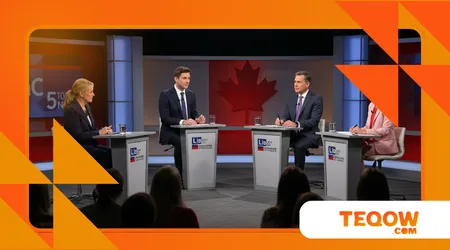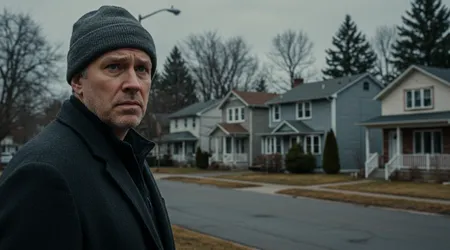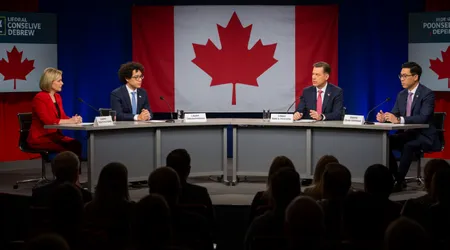Liberals and Conservatives Outline Competing Plans for Affordable Housing and Cost-of-Living Relief

Liberals and Conservatives outline competing plans to tackle Canada’s housing crisis and soaring living costs, dominating the 2025 election discourse.
With home prices skyrocketing and inflation squeezing wallets, both parties have unveiled bold, yet divergent, strategies to restore affordability.
This isn’t just political theater; it’s a defining moment for Canadians yearning for stability. From Toronto’s condo glut to Vancouver’s rental crunch, the stakes are high.
In this article, we’ll dissect their proposals, weigh their merits, and explore what’s at stake for you whether you’re a renter, buyer, or just trying to make ends meet.
Why does this matter? Because your ability to afford a home or groceries hinges on who wins this policy tug-of-war.
Let’s dive into the details, grounded in facts, with a clear-eyed look at what’s promised and what’s possible.
The Housing Crisis: A National Emergency
Canada’s housing market is a pressure cooker. In 2025, the average home price in Toronto hovers near $1.2 million, pricing out young families.
Renters fare no better average rents in Vancouver hit $2,800 for a one-bedroom. Both parties agree: this is a crisis. But their solutions? Night and day.
Liberals and Conservatives outline competing plans with distinct philosophies.
The Liberals, led by Mark Carney, lean on government intervention, aiming to double housing starts to 500,000 annually.
Their “Build Canada Homes” initiative pumps $25 billion into prefabricated home builders, targeting affordable units.
They’re also investing $74 million in Northern housing infrastructure, prioritizing Indigenous communities.
Contrast that with the Conservatives’ market-driven approach. Pierre Poilievre’s plan promises 2.3 million homes in five years by slashing red tape and taxes.
++ Bloc Québécois Calls for Wage Subsidy to Support Workers Affected by Trade War
They’d axe GST on new homes under $1.3 million, saving buyers up to $65,000. Cities must boost housing by 15% annually or lose federal funds a stick, not a carrot.
What’s the catch?
The Liberals’ reliance on public spending risks ballooning deficits, while the Conservatives’ deregulation might favor developers over affordability. Which plan truly serves Canadians?

Liberals’ Vision: Government as Builder
Mark Carney’s Liberals see government as the linchpin for housing relief. Their plan hinges on massive investment and zoning reforms.
They’d streamline municipal approvals, incentivizing cities to fast-track permits. It’s a top-down strategy, with $22 billion earmarked for housing supports.
Beyond bricks and mortar, Liberals and Conservatives outline competing plans for affordability. Liberals propose a one-percentage-point tax cut for low-income earners, easing monthly budgets.
They also plan to cap public service growth, using AI to trim bureaucracy, freeing funds for social programs.
Also read: Tax Benefits for Canadians: What You Need to Know
Real-world example: In Nunavut, Liberal pledges of $66 million for Indigenous housing could transform communities like Iqaluit, where overcrowding is rampant.
But can they deliver without drowning in red ink? A 2025 CBC report notes Canada’s deficit is projected at $62.3 billion for 2025-26, raising eyebrows about fiscal sustainability.
The Liberals’ strength is their focus on underserved groups, but their spending-heavy approach sparks skepticism. Will taxpayers foot the bill for ambitious promises?
And can government-led projects keep pace with demand?
Conservatives’ Blueprint: Unleash the Market
Pierre Poilievre’s Conservatives take a different tack: let the market breathe. They’d slash GST on new homes and match municipal tax cuts up to $50,000 per home.
Their logic? Lower costs spur construction, driving down prices.
Liberals and Conservatives outline competing plans, but Conservatives prioritize results over process.
They’d tie federal infrastructure funds to housing targets build 15% more homes yearly, or lose cash for roads and transit. It’s a bold ultimatum to cities like Toronto, where approvals lag.
Imagine a young couple in Calgary eyeing a $900,000 starter home. The Conservative GST cut could save them $45,000, making the leap to ownership feasible.
But critics argue this benefits developers more than buyers. A 2025 Globe and Mail analysis warns deregulation could flood markets with luxury condos, not affordable units.
The Conservatives’ plan is lean and incentive-driven, but it assumes markets self-correct. What if developers pocket savings instead of passing them on?
And will penalizing cities spark cooperation or resentment?
Cost-of-Living Relief: Beyond Housing
Housing isn’t the only pinch groceries, gas, and utilities are eating Canadians’ paychecks.
Liberals and Conservatives outline competing plans to ease these burdens, each reflecting their core values.
Liberals lean on targeted relief; Conservatives bet on broad tax cuts.
The Liberals’ $2 billion strategic response fund aims to shield industries like autos from U.S. tariffs, preserving jobs and stabilizing prices.
They’d also tweak industrial carbon taxes to keep Canadian firms competitive, indirectly curbing inflation. It’s a nuanced play, but will it trickle down to your grocery bill?
Conservatives, meanwhile, propose dropping the lowest tax bracket from 15% to 12.75%, putting more money in workers’ pockets.
They’d also create a $3 billion “Keep Canadians Working Fund” for businesses hit by tariffs, aiming to prevent layoffs.
This could help someone like Maria, a Windsor factory worker, keep her job amid trade tensions.
Yet, both plans face hurdles. Liberals risk overcomplicating relief with red tape, while Conservatives’ tax cuts might not reach the poorest.
Which approach hits the mark for everyday Canadians?
Comparing the Plans: A Tale of Two Futures
To make sense of Liberals and Conservatives outline competing plans, let’s break it down.
The Liberals’ interventionist model bets on government muscle, while Conservatives trust markets to deliver.
Both aim to cut taxes on new homes, but their scope differs Liberals cap at $1 million for first-time buyers; Conservatives go up to $1.3 million for all.
Here’s a snapshot:
| Party | Housing Goal | Tax Relief | Funding Approach |
|---|---|---|---|
| Liberals | 500,000 homes/year | GST cut on homes under $1M (first-time buyers) | $25B for prefab homes, $74M for North |
| Conservatives | 2.3M homes in 5 years | GST cut on homes under $1.3M (all buyers) | Tie funds to 15% housing growth |
A 2025 Nanos poll shows 41% of Canadians favor Liberals’ targeted approach, but 38% back Conservatives’ broader cuts, reflecting a divided electorate.
The Liberal plan is like a surgeon’s scalpel precise but slow.
Conservatives wield a sledgehammer, aiming for speed but risking collateral damage. Which aligns with your vision for Canada?
The Bigger Picture: Trade and Economic Stability
The 2025 election isn’t just about homes it’s about navigating global headwinds. U.S. tariffs under President Trump loom large, threatening Canada’s economy.
Liberals and Conservatives outline competing plans to counter this, with housing and cost-of-living relief tied to trade resilience.
Liberals propose a $2 billion fund to bolster industries like automotive, protecting jobs in places like Oshawa.
They’d also deepen U.S.-Canada mineral cooperation to counter China’s dominance, per a 2025 Hill report. This could stabilize supply chains, keeping prices in check.
Conservatives counter with a $3 billion loan fund for tariff-hit businesses, plus redirecting foreign aid to domestic priorities like military and tax relief.
It’s a “Canada-first” stance, but slashing aid could strain global ties, indirectly affecting trade.
Picture a chessboard: Liberals play defensively, fortifying key pieces; Conservatives go all-in, sacrificing pawns for a quick win.
Both strategies have merit, but missteps could cost dearly. Can either party balance domestic relief with global pressures?
What’s at Stake for Canadians?

This isn’t just policy wonkery it’s your rent, your mortgage, your grocery cart. Liberals and Conservatives outline competing plans that will shape your financial future.
A Liberal win might mean more affordable rentals but higher deficits. A Conservative victory could lower taxes but risk market-driven inequality.
Consider Sarah, a Vancouver barista earning $40,000. The Liberal tax cut could save her $400 yearly, while Conservative cuts might net $900.
But if housing costs don’t drop, she’s still stuck renting. The choice isn’t simple stability versus speed, equity versus efficiency.
Polls show Liberals leading by 5 points as of April 25, 2025, but the gap is tightening. Every vote counts, especially in swing ridings like Vaughan-Woodbridge.
Will you back the steady hand or the bold swing? Your call could tip the scales.
Conclusion: A Fork in the Road
Canada stands at a crossroads. Liberals and Conservatives outline competing plans, each promising relief but pulling in opposite directions.
The Liberals’ vision government-led, inclusive appeals to those seeking equity but risks fiscal strain. The Conservatives’ market-driven push offers speed and savings but might widen gaps.
Both tackle the housing crisis and cost-of-living crunch, yet neither is flawless.
This election, set for April 28, 2025, is your chance to shape the future. Will you choose the Liberals’ calculated rebuild or the Conservatives’ bold reset?
The data is clear: Canada’s deficit, housing starts, and trade policies hang in the balance.
But the real question is personal what future do you want for your family, your city, your country?
Reflect on Sarah’s struggle, the Iqaluit housing crunch, or Maria’s job at risk. These aren’t just policies; they’re lives. Vote with eyes open, because Canada’s next chapter depends on it.
Frequently Asked Questions
1. How do the Liberal and Conservative housing plans differ in scope?
Liberals focus on 500,000 homes yearly with $25 billion in prefab funding, targeting affordability. Conservatives aim for 2.3 million homes in five years, cutting GST and tying funds to city targets.
2. Will these plans lower my rent or grocery costs?
Possibly. Liberal investments may boost rental supply, easing prices. Conservative tax cuts could increase your disposable income. But neither guarantees immediate relief—implementation matters.
3. Are the tax cuts realistic given Canada’s deficit?
The $62.3 billion deficit (2025-26) raises concerns. Liberals plan AI-driven savings; Conservatives prioritize spending cuts. Both face scrutiny over long-term fiscal health.
4. How do U.S. tariffs affect these plans?
Tariffs threaten jobs and prices. Liberals’ $2 billion fund and Conservatives’ $3 billion loan program aim to cushion the blow, but effectiveness depends on trade talks.
5. Which party’s plan is better for first-time homebuyers?
Liberals’ GST cut is narrower ($1M cap, first-time buyers). Conservatives’ broader cut ($1.3M, all buyers) offers more flexibility but may favor higher earners.
